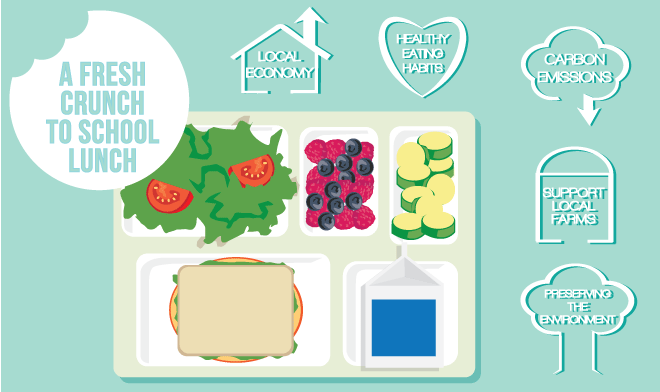On October 24th, U.S. Food Day, the organization Center for Science in the Public Interest (CSPI) is bringing attention to four key areas in which food system change needs to begin: in food education, food and health, schools, and college campuses. Throughout the week leading up to Food Day, Food Tank will recognize ways in which American youth – from young children to young adults – are shaking up the food system.
A Fresh Crunch in School Lunch, published by the Public Health Association of British Columbia, is a step-by-step guide into designing and implementing a sustainable Farm to School program. Targeted toward educators, parents, administrators, and health professionals, this guide provides advice, tools, and ideas on how to establish, promote, and evaluate a Farm to School program in local communities across Canada.
Farm to School programs can help connect schools with local farms to bring fresh, nutritious and local food to students. In addition to providing healthy meals to youth, this school-based program educates students about health and nutrition, agriculture, and their local food system. While A Fresh Crunch in School Lunch was published in Canada, there is a National Farm to School Network in the U.S. also, with 10,000 schools participating in all 50 states and Washington, D.C.
With the rise in childhood obesity, diabetes, and other diet-related chronic diseases, Farm to School programs have a multitude of health and economic related benefits. Students are introduced to healthy eating habits at a young age, while learning about the importance of supporting local farmers and preserving the environment.
In the introduction to their guide, authors of A Fresh Crunch in School Lunch advocate that by choosing foods that are grown, harvested, and processed as close to the school as possible, the community is able to support local farmers and the local food economy. This, in turn, helps cut down on carbon emissions related to food transportation, while raising awareness about environmental waste.
Understanding that regions differ based on their context and environment, A Fresh Crunch in School Lunch allows for communities to tailor a Farm to School program that is sensitive to the diversity of their schools and compatible with the available resources.
Currently, more than 20,000 students across BC benefit from Farm to School programs that were developed with this guide.















